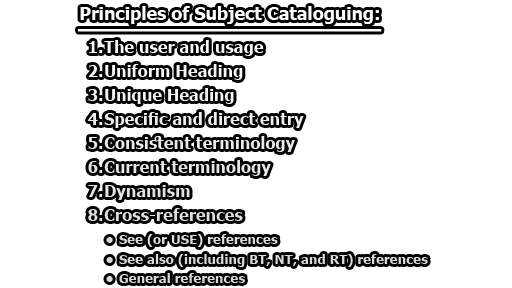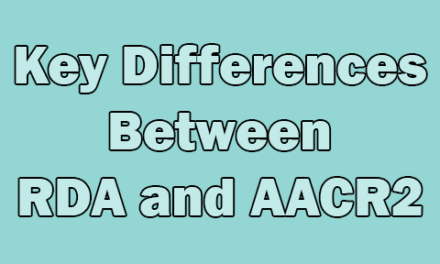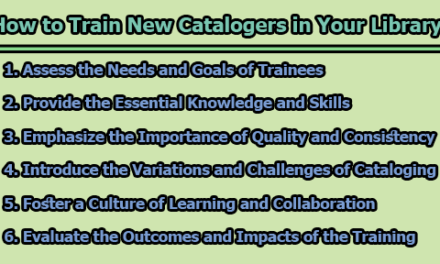Subject Cataloguing:
In addition to author and title entries, library catalogues and other bibliographic retrieval tools provide a topical approach to the records in their system through access points that represent subject content. The title of work often does not clearly or completely indicate the subject content of the item, additional subject access points are used frequently to evaluate the relevancy of the retrieval items to the searchers’ interest. In this article, we are going to present to you definitions and principles of subject cataloguing.
Definitions of Subject Cataloguing:
Subject cataloguing is made of entries for subjects arranged in alphabetical order. There are some definitions of subject cataloguing are given below:
“Subject cataloguing is any catalogue arranged by subjects, whether in alphabetical or classified order.” (Harrods Librarians Glossary and Reference Book)
“Subject cataloguing is that part of cataloguing which involves the allocation of subject headings to entries for specific books or other documents.” (Wikipedia)
“A form or part on of the library cataloguing process that not only describes a title but also classifies it and assigns subject heading.” (Merriam Webster)
From the above definitions, we can say that “Subject cataloguing is the terms which is assigned to each record, each term normally represents only one subject.”
Principles of Subject Cataloguing:
The rules for subject headings in a dictionary catalogue were first set forth by Charles Ammi Cutter in his ‘Rules for a Dictionary Catalog’. The basic principles of subject cataloguing/headings are described below:
1. The user and usage: For Cutter, the most significant consideration in the cataloguing of library materials was the best interest of the user. He called this principle “the convenience of the public”. On this principle, public usage becomes an important determining factor in selecting the terms and the forms of the subject heading.
2. Uniform Heading: Subject headings should be chosen with neutral, inclusive or unbiased terminology, especially regarding topics that might be controversial. References to headings are made from synonyms and variant forms.
3. Unique Heading: Each heading in LSH (Locality Sensitive Hashing) represents only one topic. If an item could represent more than one concept, it should be modified, viz, Venus (Planet) Strilts; Venus (Roman deity) Stilts (Birds) or a [heading]-[subdivision] combination as created to provide context.
4. Specific and direct entry: The principle of specific entry governs both how subject headings are formed and how they are assigned to documents. Regarding formulation, the principle requires that a heading be as specific as the topic it is intended to cover.
Cutter claimed that this rule is the main distinction between a dictionary catalogue and the alphabetic-classed catalogue. The entries in the alphabetical catalogue are that its entries are both specific and direct.
For example; the object ‘cats’ would appear under heading such as:
“Zoology – Vertebrates – Mammals – Domestic animals – Cats”
5. Consistent terminology: This form and structure of heading promote predictability of subject heading users. When headings are changed or new headings are established headings in bibliographic records need to be updated.
6. Current terminology: The terminology selected to formulate individual subject headings which is created for use in cataloguing should reflect the terminology used in current literature.
7. Dynamism: Changes to headings are made continuously to maintain the currency and viability of LSH. The benefit of making a change is weighed against its impact on the authority and bibliographic databases.
8. Cross-references: Three types of cross-references are used in the subject headings structure which are briefly described below:
- See (or USE) references: To make sure that users who happen to consult the catalogue under different names for a given subject will be able to locate the material on it, See or USE references are provided to lead them from the terms they have looked under to the authorized heading for the subject in question. These references guide users from terms that are not used as headings to be authorized headings.
- See also (including BT, NT, and RT) references: This type of reference connects headings that are related in some way, either hierarchically or otherwise. See also reference related headings that all are used as entries in the catalogue.
- By connecting related headings, the See also (RT, for Related Term) reference calls the user’s attention to material related to his or her interest.
- By linking hierarchically related headings, see also (BT, for Broader Term and NT, for Narrower Term) references restore some of the advantages of the classed catalogue in an alphabetical specific catalogue. See also references provide users with additional access points for the subject being sought.
- General references: While a specific reference directs the user from the term being consulted to another individual heading, a general reference directs the users to a group or category of heading instead of to individual members of the group or category. It is sometimes called a blanked reference.
At the end of the day we can say that subject cataloguing deals with what a book or other library item is about, and the purpose of subject cataloguing is to list under one uniform word or phrase all the materials on a given topic that a library has its collection.

Assistant Teacher at Zinzira Pir Mohammad Pilot School and College










